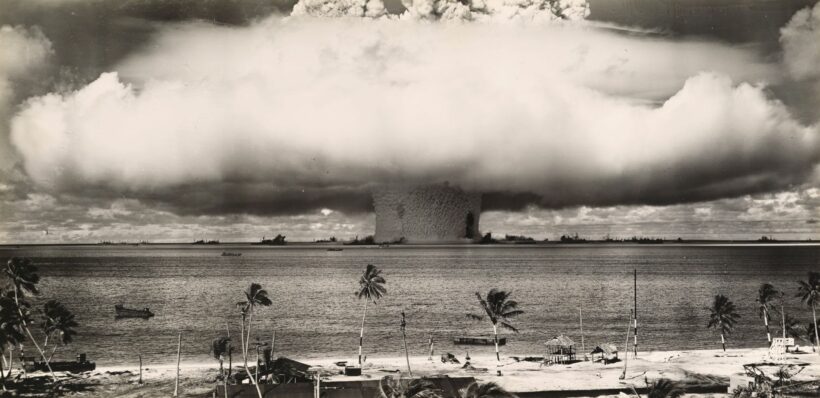The presence of Polish, French, British and American soldiers in the Ukrainian-Otanian offensive on the Russian region of Kursk would be a confirmation of NATO’s entry into open conflict with Putin’s Russia, which according to the Russian nuclear doctrine, would allow Putin to use «non-strategic» nuclear weapons, also known as «tactical nuclear weapons», according to the Nuclear Threat Initiative (NTI).
Do globalists seek direct NATO-Russia confrontation?
As the US is engaged in the campaign for the November Presidential elections, France, Poland and the UK would be the trident chosen by the globalists to implode the Ukrainian front before the November Presidential Elections and provoke the entry of NATO into an open conflict with Russia.
Poland seeks to become a local player in the Eastern European hornet’s nest and extend its influence into the Ukrainian zone by claiming its right to incorporate the Ukrainian region of Lviv, which was already occupied by Poland from 1918 to 1939, on the Polish map.In a statement by the Russian Foreign Ministry, Russia has warned that «the arrival of F-16 fighters in Ukraine will be seen as carriers of nuclear weapons and we will consider this step by the US and NATO as a deliberate provocation», while accusing the West of openly supporting Ukrainian sabotage on Russian territory and supplying British and French long-range missiles to Kiev as well as new US ATACMS with which they have reached Russian territory.
In the dynamic of action-reaction of the new Cold War 2.0 scenario, Putin ordered his country’s Armed Forces to conduct tactical nuclear weapons maneuvers on the southern border with Ukraine. This would be a Russian response to the assertions of French president Emmanuel Macron and other senior British and Polish officials that they are «ready to send military contingents to Ukraine», elite soldiers who would have already deployed in the Ukrainian surprise attack on the Russian region of Kursk.
Nuclear Doctrine of Russia
Formally known as the ‘Basic Principles of State Policy on Nuclear Deterrence’, it was signed by Putin in 2020 and describes when Russia could draw on its atomic arsenal.
The document states that “nuclear deterrence aims to provide a potential adversary with an understanding of the inevitability of retaliation in case of aggression against the Russian Federation and its allies”.Russia could use them, says the doctrine, “in response to the use of nuclear and other weapons of mass destruction against it or its allies” as well as “in case of aggression against the Russian Federation with the use of conventional weapons when the very existence of the state is endangered”.
Accordingly, according to this doctrine the Russian Federation will be able to use its nuclear arsenal in case “an enemy attack with conventional weapons threatens the existence of Russia”, which would be carried out in the current Ukrainian-Otanian military operation in Kursk.
NATO military operation in Kursk?
The proven presence of Polish, French, British and American soldiers in the offensive on Kursk would be a confirmation of NATO’s entry into open conflict with Putin’s Russia, which according to the Russian Nuclear Doctrine, would allow Putin to use «non-strategic» nuclear weapons, also known as «tactical nuclear weapons», according to the Nuclear Threat Initiative (NTI) and of which Russia would possess about 1,800 warheads and NATO would have deployed 250 warheads in Europe.
The incursion into Kursk is the largest attack against sovereign Russian territory since the start of the military conflict with Ukraine as a minimum of 1,000 Ukrainian soldiers led by NATO elite forces and supported by tanks and armoured vehicles would have invaded territory Russian and reached about 10 km deep, while Russia, after overcoming the initial surprise, has decreed a special regime of “counter-terrorism operation” in three regions bordering Ukraine: Kursk, Belgorod and Briansk.
The objective of the Ukrainian-Soviet offensive otaniana would force the Russian command to withdraw troops from other sensitive areas of the front and occupy the nuclear power plant near the city of Kurtsov to subsequently consolidate the positions reached and use them as weapons of pressure in future peace negotiations.
Use of tactical nuclear weapons?
For the time being, the Russian Armed Forces have chosen to use the three-ton FAB-3000 aerial bomb over a zone of concentration of troops and weapons of the Ukrainian Army in the Sumi region, from where “Kiev would have launched its ground incursion into the Kursk region”, according to the Russian Defense Ministry but assuming that the advance of the Ukrainian-Otanian incursion is unstoppable, Russia could opt for the use of tactical nuclear weapons.
Tactical warheads refer to those designed for use in a limited battlefield, for example, to destroy a column of tanks or a carrier battle group if used at sea, so they are also known as «low-performance».However, according to the Union of Concerned Scientists (U.S.), a Princeton University simulation of a US-Russian conflict that begins with the use of a tactical nuclear weapon predicts «a rapid escalation that would leave more than 90 million dead and wounded», with the result that the start of a low-intensity nuclear conflict could degenerate into a large-scale nuclear conflagration with disastrous results for humanity.






